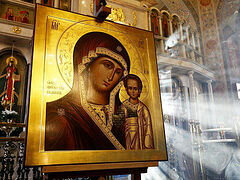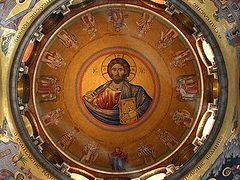Protestant critics of Orthodoxy fault us for many things, but one of the foremost of their objections is our devotion to Mary, the Mother of Jesus. Hostility to Roman Catholicism is built into Protestant DNA, so anything in Orthodoxy that resembles something in Roman Catholicism will be subject to criticism, including such more or less innocuous things like clergy wearing cassocks and calling themselves “Father”. Our Orthodox devotion to Mary (whom we call “the Theotokos”) often heads the list of Protestant objections, since it features so prominently in Roman Catholicism.
Admittedly we share many things with our Roman Catholic friends in our devotion to our Lord’s Mother. Given that Christ is God, we call His Mother “the Mother of God” as do our Roman Catholic friends, and pray to her, asking for her prayers and help. We both confess that she was perpetually virginal, and have a strong liturgical tradition praising her and asking for her prayers. But there are differences between us and our Roman Catholic friends as well, and these are not insignificant. I would like to expound on them here.
First of all is the RC dogma of the “Immaculate Conception” (which has nothing to do with our Lord’s virginal conception/ birth). The idea behind the dogma is that when Mary was conceived in the womb of St. Anna, there was an infusion of sanctifying grace along with the physical components of her conception so that she was conceived and sanctified at the same time.
The dogma was proclaimed in 1854 as a kind of “escape hatch” from a dilemma bequeathed to the western church by the teachings of St. Augustine who had unknowingly painted the western church into a corner. That great western Father taught that everyone in the world was conceived and born with taint of original sin—i.e. the damning guilt of Adam, so that infants and children dying unbaptized went to hell. (The eastern part of the Church never followed him in this.) This meant that everyone was born into the world as an object of God’s wrath and continued to be so until they were baptized.
It was thought by many that it was unbearable to imagine that our Lord’s Mother was ever such an object of divine wrath, and so debate about this continued in the medieval western church. Anselm taught that she was conceived and born in sin (in his Cur Deus Homo); Bernard (and later Aquinas) taught she was conceived in sin but sanctified before birth. The Franciscans argued for a sinless conception. For Roman Catholics the issue was decisively settled by the papal bull Ineffabilis Deus by Pope Pius IX in 1854. The bull stated that “Mary was in the first instant of her conception, preserved untouched by any taint of original guilt, by a singular grace and privilege of Almighty God, in consideration of the merits of Christ Jesus the Saviour of mankind”.
The Orthodox reject this teaching, since we never believed that anyone in the world was born with “taint of original guilt”, and so we never needed the doctrinal escape hatch offered in Ineffabilis Deus.
A greater problem than the doctrinal definition of 1854 is the psychological gap it seems to introduce separating the Theotokos from the rest of us. In the words of the late Fr. Thomas Hopko, in Roman Catholic thought Mary becomes not so much the Great Example for us, as the Great Exception. That is, whatever RC dogmas actually teach about Mary, in popular piety she was a disconcerting tendency for her to stray over the line and take her place not among us, but among the Holy Trinity.
I remember seeing this part of popular piety illustrated in a Roman Catholic retreat house where I once stayed. There were crucifixes and devotional plaques throughout the place, and one plaque invoked a fairly minor saint (possibly by the name of “Mary Theresa”, though memory fails) saying, “Mary Theresa, pray to Jesus and Mary for us!”
Note: not (as in Orthodoxy) “pray to God for us” or “pray to Christ God for us”, but “pray to Jesus and Mary for us”. St. Mary Theresa might be one of us, but Mary the Mother of Jesus was not. She was the Great Exception, sharing the immaculate sinlessness of God Himself. No doubt the writer of the devotional sentiment was not so idiotic as to imagine that Mary was a part of the Holy Trinity as was Jesus, but that is just the point: the sentiment witnessed to an unconscious devotional tendency, an unthinking emotional drift.
Such a drift is impossible in Orthodoxy, where the dividing line between the Theotokos and her Son is constantly emphasized. For example, in Orthodoxy every church service ends with a dismissal which reads like this: “May Christ our true God, through the prayers of His most pure Mother, of the holy, glorious, all-laudable apostles, of the holy and righteous ancestors of God Joachim and Anna, and of all the saints, have mercy upon us and save us”.
Note: Mary the Theotokos here stands with the rest of the Church and its saints interceding for us with Christ. She stands with the holy, glorious, all-laudable apostles, with the holy and righteous ancestors of God Joachim and Anna, and with all the saints—and therefore with us on our side of the dividing line separating Christ from His Church. (We see this visually in the Deesis icon, in which Christ is enthroned and His Mother and His Forerunner stand on either side of Him, with their hands upraised in intercessory prayer; see inset image at top.) Given this liturgical constant in Orthodox diet, we are not likely to see a plaque saying “St. Olga of Alaska, pray to Jesus and Mary for us” any time soon. For all our shared love for Mary, the Orthodox understanding of her place is somewhat different from that of our Roman Catholic friends.
I suspect that it is this emotional difference of devotion, this unconscious and unrecognized separation of Mary from the rest of the Church that accounts for the current drive to honour her as “Co-redemptrix”—i.e. as a redeemer of the world along with her Son.
Those explaining the doctrine are careful in their definitions to safeguard the unique role played by Christ as the Lamb of God whose Blood makes atonement for the sins of the world and to make it plain that Mary has a clearly subordinate role. Such explanations seem to take away with one hand what was given by the other in the title. That is, her role as co-redemptrix is not so much explained as explained away. But then why, I ask, push for the title (and its future proclamation as dogma) at all? Is it just another example of what was once described as the “papal dogma machine running on at full throttle” so that dogmas are multiplied? Maybe. But to me it seems more likely that it is the unconscious fruit of regarding Mary as the Great Exception, an ontological sui generis, someone wholly different in constitution from the saints and us.
Certainly any talk of her as “co-redemptrix” is likely to bedevil ecumenical progress and exacerbate the differences already existing between the papal church and all others. This was even acknowledged by some Roman Catholic theologians, one of whom said that the popular petition to have the opinion proclaimed as dogma was “theologically inadequate, historically a mistake, pastorally imprudent, and ecumenically unacceptable”. True: but then why is it still being pushed by some? I answer: because it is the fruit of an unconscious tendency, not of theologizing.
The other difference regards the so-called “apparitions” of Mary in such places as Lourdes, Fatima, and Medjugorje. Admittedly I have taken no poll, but in my decades of Orthodox ministry I cannot remember a single Orthodox priest who believed in the legitimacy and truth of the Marian apparitions.
Some aspects of the apparitions do strain credulity: for example, at Fatima supposedly the Mother of God revealed upon being questioned that a child who had recently died would be in Purgatory “till the end of the world”—a disturbing thought about so young a child, which is why this answer was suppressed in some versions of the Fatima story. At Fatima Mary also supposedly promised that if Russia was consecrated to her Immaculate Heart its conversion from Orthodoxy to Roman Catholicism was promised “unconditionally”.
There is also something odd in the reported behaviour of the apparitions. For example, in the Fatima accounts Mary tells the children to come back to a certain place on the 13th of each month for the next six months, “and then I will tell you who I am and what I want”. Also, at Lourdes the young child Bernadette saw Mary using a Rosary—was Mary praying to herself? Furthermore, Bernadette did not at first know that the apparition was Mary, and referred to the “white thing in the shape of a girl” as “Aquero”—i.e. “this thing”.
The notion of the Mother of God revealing herself in this way is without precedent in the early Church. Saints (such as St. Gregory the Wonder-worker) had visions of the Theotokos, but such visions were prepared for and rendered spiritually safe by the saint’s humility, who instantly recognized the Theotokos when she revealed herself. Such revelations occurring unexpectedly to children and with such game-playing (“later I will tell you who I am”) are contrary to the Church’s Tradition, and do nothing to commend their legitimacy. Perhaps it is therefore not surprising that so few Orthodox accept the Marian apparitions as legitimate appearances of the Theotokos.
There are, I suggest, significant differences between the Roman Catholic devotion to the Mother of God and the Orthodox devotion.
Those who passionately reject any Marian devotion will of course also reject these differences as completely insignificant. As C. S. Lewis once observed, “To those who cannot endure the presence of a cat, the huge square-headed tabby Tom and the little smoke-faced goblin from Siam are all one”. But those who love cats will find the two felines distinctly (and delightfully) different. Such are the significant differences between the Orthodox and their Roman Catholic friends.





